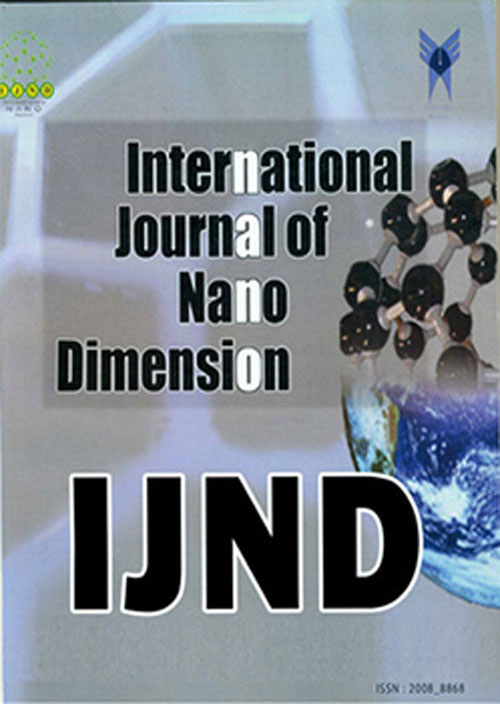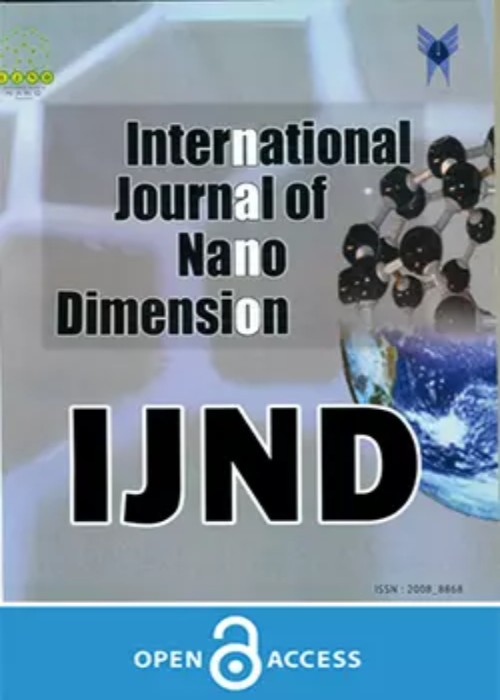فهرست مطالب

International Journal of Nano Dimension
Volume:11 Issue: 4, Autumn 2020
- تاریخ انتشار: 1399/08/17
- تعداد عناوین: 10
-
-
Pages 303-311Herein, we report multi-element doped Type-II heterostructure assembly consists of N, S doped TiO2 and ZnO for electrochemical crystal violet dye degradation studies. Electrochemical measurements were performed on these synthesized N-S codoped TiO2/ZnO compositeheterostructured assemblies which are fabricated on Titanium (Ti) substrate. It was observed that a composite electrode (N, S-TiO2/ZnO@Ti) assembly has shown better efficiency metrics in comparison to all individual electrodes (bare Ti, TiO@Ti, ZnO@Ti) highlighting the importance of heterostructures. The findings of this article will help to design economic materials for complex dye molecule degradation studies as well as paves path towards better understanding of molecular mechanisms of dye degradation.Keywords: Crystal Violet Dye, Synergistic Interaction, Type-II heterostructure, TiO2, ZnO
-
Pages 312-336Density functional theory (DFT) calculations were performed on tripeptide arginyl-glycyl-aspartic acid (RGD) as an efficient drug carrier to deliver the commercially famous cyclophosphamide (CP) anticancer drug within ethanol solution. The most negative binding energy (-5.22 kcal/mol) was measured for the CP-RGD-7 created through the H-bond interaction between the P=O (phosphoryl) oxygen atom of the CP and hydrogen atom of O-H group in the RGD. The quantum theory of atoms in molecules (QTAIM) proved that the CP-RGD-6 was composed of five intra-molecular CH…HC, N…HC and NH…OC plus one inter-molecular NH…N interactions. Among CP-RGD-6, CP-RGD-7 and CP-RGD-8 with the smallest binding energies (highest structural stabilities), the CP-RGD-6 showed the minimum hardness, energy gap and chemical potential whereas the utmost electrophilicity index and electronegativity which confirmed it could the most effectively be bound onto the cancer cells. Consequently, among twenty designed carriers, the CP-RGD-6 was recognized as the most promising drug delivery system. According to the results achieved from the molecular dynamics (MD) simulations performed in ethanol solvent on the CP-RGD-PEG systems containing different number of PEG chains, it was established that the CP-RGD-6PEG cell was the most suitable vehicle with desirable FV (4988.89 Å3) and FFV (22.66%) values as well as small drug diffusion coefficient (0.0114×10–5 cm2/s) indicating low drug release rate.Keywords: Cyclophosphamide Anticancer Drug, DFT Computations, Drug delivery, MD Simulations, Tripeptide RGD
-
Pages 337-345The spread of contagious diseases and the increase in the drug resistance amongst pathogens has enforced the researchers to synthesize biologically active nanoparticles. Development of eco-friendly practice for the synthesis of nanoparticles is growing bit by bit in the field of nano-biotechnology. The present investigation outlines the development of a method to biosynthesize copper nanoparticles (CuNPs) by mixing copper chloride solution with aqueous rhizome extract of Marsilea quadrifolia. The synthesized nanoparticles were characterized by using the UV-vis spectroscopy, Fourier Transform Infrared Spectroscopy (FTIR), Scanning Electron Microscopy (SEM), X-ray Diffraction (XRD) and Atomic Force Microscope (AFM). The UV-vis spectra showed an absorption band at 324 nm. The FTIR measurement revealed the presence of all functional groups having control over reduction and stabilization of the nanoparticles. The SEM micrograph depicts the morphology of biogenically synthesized CuNPs with leaf like structure. The X- ray diffraction pattern confirmed the formation of crystalline nature of CuNPs with an average size of 25.20 nm. Regular gravel like structure of CuNPs was displayed in the AFM image. Additionally, the biosynthesized CuNPs were found to be extremely toxic against two gram positive bacterial strains Bacillus thuringiensis and Streptococcus faecalis.Keywords: Antibacterial, Biogenic Synthesis, Copper nanoparticles, Marsilea Quadrifolia, Scanning electron microscopy (SEM)
-
Pages 346-354
In this research, the quantum mechanics calculations were carried out to elucidate the adsorption behavior of metronidazole drug on the surface of pristine as well as doped C60 fullerene with Si, B and Al using density functional theory (DFT) at B3LYP/6-31G(d,p) level. After optimization of the structures, various parameters such as HOMO and LUMO energies, gap energy, adsorption energy, chemical hardness, chemical potential, dipole moment, electrophilicity index and thermodynamics data were calculated. The results showed that by substitution of the carbon atom in the C60 fullerene with Si, B and Al, the amounts of gap energy and chemical hardness are decreased, while those of chemical potential and electrophilicity index are increased. It means that the doping of C60 by Si, B and Al leads to an increase in drug reactivity. Also, the binding and stabilization energies are increased by doping of C60. The thermodynamic results suggested that substitution on the pristine C60 leads to a more negative in the value of the Gibbs energy and subsequent spontaneous process.
Keywords: Chemical potential, C60 Fullerene, Density functional theory (DFT), doping, metronidazole -
Pages 355-363In this research, Zn2SnO4 nanorods were prepared and structural properties of the nanorods were characterized, developing of wide-range of the optical behavior of Zn2SnO4 nanorods and the antibacterial activity was also investigated using a microwave-assisted method. A zinc stannate (Zn2SnO4) nanorod was synthesized via facile microwave-assisted method using ammonia with cubic spinel structure. The crystallography and optical properties were studied using X-ray diffraction and photoluminescence spectroscopy. The morphology of the nanoparticles was observed using field emission scanning electron microscopy. The antibacterial effect of Zn2SnO4 nanoparticles tested against Gram-positive and Gram-negative pathogenic bacteria was investigated. The Zn2SnO4 nanorods showed the excellent antibacterial activity, the inhibition zone indicates the biocidal action of Zn2SnO4 nanorods. Here, we concluded that these materials were used as a bactericidal agent to prevent and control the spread and persistence of infectious diseases.Keywords: Antibacterial activity, nanoparticles, Nanoarchitectonics, PL, Zinc Stannate
-
Pages 364-376In this study a sensitive electrochemical sensor for the detection of E.coli has been developed using silver nanoparticle (Ag) embedded poly(9,9-dioctylfluorene-ran-phenylene) (CFP) nanocomposite as a conductive platform and DNA hybridization technique. The new polymer was synthesized from 9,9-dioctylfluorene and 1,3-dichlorobenzene and biphenyl through Friedel Crafts alkylation reaction and the synthesized polymer as well as the Ag nanoparticles loaded composite were characterized using Fourier-transform infrared spectroscopy (FTIR), Nuclear Magnetic Resonance (NMR), X-ray powder diffraction (XRD), Scanning Electron Microscopy (SEM) and Transmission Electron Microscopy (TEM) analysis. For accurate and rapid label-free electrochemical detection of pathogenic bacteria such as E.coliwas studied by spin coating the nanocomposite suspension into indium tin oxide electrode (ITO) followed by the immobilization of aminoterminated oligonucleotide (pDNA), as probe. The resultant pDNA/Ag-CFP/ITO biosensor was then used to detect ssDNA, cleaved from genomic DNA of E.coli, using differential pulse voltammetry (DPV) technique. Under optimal experimental conditions, the biosensor could detect ssDNA in a wide linear range from 1 × 10-15 M to 1 × 10-22 M with a lowest detection limit of 1 × 10-22 M.Keywords: Conductive Nanocomposites, DPV Sesnor, E. Coli Detection, Electrochemical sensor, Polyfluorene Derivatives
-
Pages 377-391Nanostructured Ni1-xLnxSb2O6 (Ln = Eu, Gd, Ho and Yb) powders were synthesized via stoichiometric 1:2 Ni:Sb molar ratio by solid state reaction at 800 ºC for 8 h using Ni(NO3)2, Sb2O3, Eu2O3, Gd2O3 and Ho2O3 raw materials. The synthesized materials were characterized by X-ray diffraction (XRD) technique. Structural analyses were done by FullProf program employing profile matching with constant scale factor. The results showed that the patterns had a main orthorhombic NiSb2O6 crystal structure with P42/mbc space group. The morphologies of the synthesized materials were studied by field emission scanning electron microscope (FESEM) which showed that the synthesized samples had sponge morphology. Ultraviolet – Visible (UV-Vis) spectroscopy showed that the smallest direct optical band gap energies were in the ranges of 1.6 to 1.8 eV suggesting a high efficient photocatalytic activity. Photocatalytic performance of the synthesized nanomaterials was investigated for the degradation of pollutant Malachite Green (MG) in aqueous solution under visible light condition. It was found that the optimum conditions were 0.04 mL H2O2, 30 mg catalyst, and 35 min reaction time. It was found that the synthesized NiSb2O6 nanocatalyst had very good efficiency in aqueous solution under the optimized conditions at the presence of visible light irradiation. The degradation yield at the optimized conditions was 96 %. The optimum photocatalytic condition was used to study the performance of the other synthesized materials in the photocatalytic degradation process.Keywords: Dye degradation, Full Prof, Malachite green, Nanocatalyst, Solid state
-
Pages 392-398By applying tensile local uniaxial strain on 5 nm of drain region and compressive local uniaxial strain on 2.5 nm of source and 2.5 nm of channel regions of graphene nanoribbon tunneling field-effect transistor (GNR-TFET), we propose a new bandgap-engineered (BE) GNR-TFET. Simulation of the suggested device is done based on non-equilibrium Green’s function (NEGF) method by a mode-space approach. Simulation results show that, compared to the conventional GNR-TFET, the BE-GNR-TFET enjoys from a better am-bipolar behavior and a higher on-current. Besides, the analog characteristic of the proposed structure such as transconductance (gm) and unity-gain frequency (ft) is also improved.Keywords: Density of States (DOS), Graphene Nanoribbon (GNR), Non Equilibrium Green’s Function (NEGF), Tunneling Field Effect, Unity Gain Frequency (ft)
-
Pages 399-404
Particulate matter is defined as a mixture of airborne solid particles and liquid droplets that can be inhaled and may cause serious health problems. Such elements are currently measured utilizing air quality monitoring devices that provide information on PM 10 and PM 2.5 levels giving information on pollution levels. However, many difficulties are encountered in the determination of nanosized ultra fine particles (UFPs) due to their reduced dimensions. The present paper highlights the ability of low cost air quality monitors to estimate UFPs concentration through a correlation based on the measures of PM 10 and PM 2.5.
Keywords: Air Quality Detectors, Light Scattering, nanoparticles, Particulate Matter, Toxicology -
Pages 405-411
In this research we are synthesized CuO nanoparticles (NPs) using water extract of. Also the total phenolic content of Sambucusnigra L. leaves water extract was measured by the Folin-Ciocalteu method. For confirmation the structure of synthesized bio-CuO-NPs we are employed X-ray Diffraction (XRD), Ultraviolet-visible (UV–vis), Fourier Transform Infrared (FTIR) spectroscopies, Scanning Electron Microscopy (SEM), and Transmission electron microscopy (TEM) methods that indicated that synthesized bio-CuO NPs have crystalline face-centered cubic (fcc) CuO phase with spherical morphology and with size about 14 nm. It should be mentioned that two different temperatures (100 and 400 o C) caused to Cu and CuO NPs respectively.
Keywords: Aqueous extract, Bio-CuO nanoparticles, Sambucusnigra L, Total phenolic contents, Transmission Electron microscopy (TEM)


